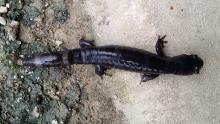Reptiles and Amphibians
Media

Species Types
Scientific Name
Plethodon albagula
Description
The western slimy salamander is a black to blue-black salamander irregularly marked with silvery flecks. It occurs in the Ozark Highlands and the Lincoln Hills north of the Missouri River. True to its name, it secretes a thick substance that sticks to skin like glue.
Media

Species Types
Scientific Name
Eurycea lucifuga
Description
The cave salamander is a common amphibian of the Ozark Plateau. It lives in caves, springs, and rocky streams. Recognize it by its normally bright orange skin dotted with dark brown or black spots.
Media

Species Types
Scientific Name
Ambystoma opacum
Description
The marbled salamander is a small, stout salamander with silvery, white, or gray saddle-shaped markings on its body from head to tail. They occur in the southeastern half of the state and are seldom encountered except during the autumn breeding season.
Media

Species Types
Scientific Name
Ambystoma annulatum
Description
The ringed salamander is secretive, spending most of its time under logs or rocks or in burrows. The rings never completely encircle the body. It occurs in the southwestern and central Missouri Ozarks, and in the river hills of the Missouri River in eastern Missouri.
Media

Species Types
Scientific Name
Ambystoma maculatum
Description
The spotted salamander is one of Missouri's six species of mole salamanders. It is slate black with two irregular rows of rounded yellow spots from the head onto the tail. It occurs in forests in the southern two-thirds of the state.
Media

Species Types
Scientific Name
Lampropeltis calligaster
Description
The prairie kingsnake is fairly common over most of the state. The overall color is tan, brownish gray, or greenish gray. Numerous dark blotches down the back and sides are brown, reddish, or greenish brown. It lives in prairies, open woods, and rocky, wooded hillsides, statewide.
Media

Species Types
Scientific Name
Heterodon platirhinos
Description
The eastern hog-nosed snake is a nonvenomous snake that is highly variable in color and pattern. It has an upturned snout and can hiss loudly and spread its neck like a cobra. If this defense fails, the snake may thrash around, open its mouth, roll over, and play dead.
Media

Species Types
Scientific Name
Heterodon nasicus
Description
The plains hog-nosed snake has probably been extirpated from Missouri. It has a sharply upturned snout, black pigment on the underside of the tail, and was only known from the loess hill region of extreme northwest Missouri.
Media

Species Types
Scientific Name
Pantherophis emoryi
Description
The Great Plains ratsnake is seldom seen. It has numerous brown blotches along the body, a brown eye stripe, and a spearhead marking on top of the head.
Media

Species Types
Scientific Name
Pantherophis ramspotti
Description
The western foxsnake is a moderately large snake with distinct brown blotches. In Missouri, it is rare and found only in our far northwestern counties.
See Also
About Reptiles and Amphibians in Missouri
Missouri’s herptiles comprise 43 amphibians and 75 reptiles. Amphibians, including salamanders, toads, and frogs, are vertebrate animals that spend at least part of their life cycle in water. They usually have moist skin, lack scales or claws, and are ectothermal (cold-blooded), so they do not produce their own body heat the way birds and mammals do. Reptiles, including turtles, lizards, and snakes, are also vertebrates, and most are ectothermal, but unlike amphibians, reptiles have dry skin with scales, the ones with legs have claws, and they do not have to live part of their lives in water.





















